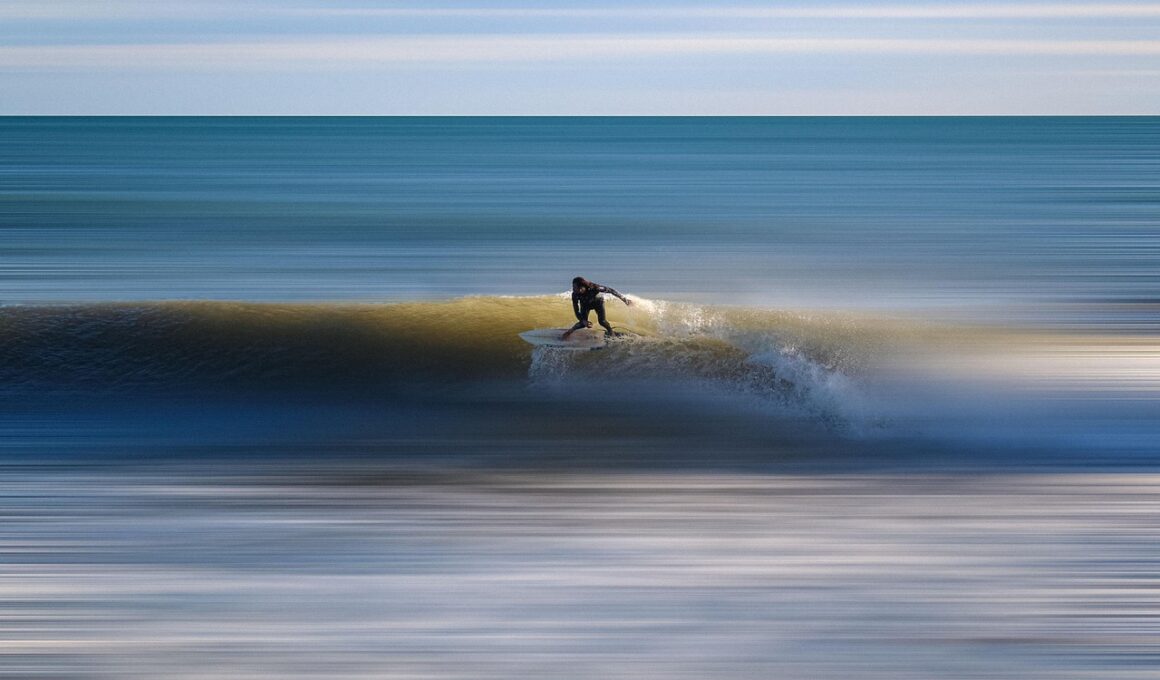Water Sports and Environmental Fitness Concerns: Promoting Sustainability
Water sports are incredibly popular worldwide, drawing millions of enthusiasts annually. However, this enjoyment comes at a cost to our oceans. These recreational activities can negatively impact marine ecosystems, prompting the need for substantial awareness. Adopt sustainable practices while indulging in water sports to ensure you minimize your ecological footprint. For instance, consider using biodegradable products for skin protection. No-wake zones can mitigate erosion caused by motor sports. It’s vital for sports enthusiasts to be informed about their environmental impact. Programs focusing on conservation can enhance both the education and the effective stewardship of our oceans. Initiatives that promote responsible behavior, like not littering and respecting wildlife, should be considered essential learning components. Collaboration among stakeholders is crucial; local communities, athletes, and governments must unite. Natural habitats thrive when we use eco-friendly equipment and follow environmental regulations. Whether kayaking, surfing, or sailing, a conscientious approach will significantly facilitate ocean preservation. Embrace stewardship by actively participating in beach clean-ups and supporting conservation organizations to rejuvenate marine health. Identify and adopt best practices in your activities, creating a sustainable harmony between recreation and conservation, thus preserving our oceans for future generations.
The Role of Education in Ocean Preservation
Education plays a pivotal role in motivating individuals towards sustainable water sports. Educational programs emphasizing ecological health are necessary to enlighten participants about broader environmental issues. Outdoor education integrates physical activities with learning. Hence, educators can craft programs that foster fishing ethics, sustainable boating practices, and safe diving operations. Sports organizations should prioritize teaching the importance of observing marine life without disturbing their habitats. Include workshops focused on teaching proper techniques for gear usage, which directly contribute to less ocean damage. Collaborate with local schools and community centers to ignite interest among younger generations. Engaging them in discussions about marine ecosystems fosters a sense of responsibility while they enjoy water activities. Schools can incorporate visits to marine sanctuaries to allow firsthand experience with these remarkable ecosystems. On a larger scale, achieving widespread recognition of respectful practices elevates the discourse on sustainable sports. Participants should be aware of their shared responsibility in protecting marine life. By integrating these values into sporting activities, we empower individuals to become environmental stewards, ultimately leading to collective efforts towards ocean preservation. Education thus becomes a muscle, strengthening the resolve to engage in conservation-focused practices through informed and passionate engagement.
One effective way to promote ocean preservation through water sports is to establish guidelines and regulations governing practices. Many sports, especially those involving motorized vehicles, can cause significant disruptions to ecosystems. Hence, implementing stricter policies can promote responsible participation. Regulatory measures can include designating specific areas for different types of activities. These designated zones allow for a practical approach, ensuring no harm comes to sensitive regions of marine biodiversity. Players in the water sports industry must unite in adherence to these regulations by practicing restraint in their outings. Furthermore, companies can spearhead campaigns that inform users of the environmental impact of their equipment choices. Encouraging choices between traditional materials and innovative biodegradable ones alters the landscape of perils faced by ocean life. The participation of athletes in creating or endorsing these guidelines fosters greater respect for their implementation and purpose. Moreover, supportive community initiatives can enhance volunteer efforts towards enforcing these standards. Together, regulation and community action forge a path towards rejuvenating damaged marine ecosystems while allowing for continued enjoyment of delightful water sports experiences.
Community Initiatives for Sustainable Water Sports
Community initiatives represent another vital aspect of fostering sustainability in water sports. Collaborative projects can bring together participants, organizations, and volunteers to enhance the state of our waters. Examples of initiatives include local clean-up days, educational workshops, and responsible marine tourism programs. Coordinating clean-up efforts generates enthusiasm while encouraging accountability among participants. Events such as these make it easier for people to contribute positively, merging fun with responsibility. Educational workshops can provide insights into the significance of preserving marine environments. By showcasing marine flora and fauna and their roles within the ecosystem, individuals gain a deeper appreciation that inspires conscientious actions. Establishing a network of responsible sports enthusiasts becomes a powerful tool for advocacy. Promoting sustainable tourism also supports local economies while furthering environmental goals. Moreover, tourism linked to ocean preservation efforts creates greater awareness and enhances the appreciation of natural resources. Consequently, local communities reap the dual benefits of economic enhancement and ecological resilience. Collective initiatives help foster harmony between recreation and conservation through practical engagements and meaningful dialogue about examining and improving our practices.
In the face of climate change, water sports enthusiasts must adapt their practices for environmental impact. Rising sea levels, increased temperatures, and altered weather patterns pose specific threats to the ocean environment. Such changes affect not only marine animals but also recreational opportunities enjoyed by many. Advocating for climate-resilient practices involves modifying gear choices, like selecting lightweight materials that reduce the carbon footprint. Additionally, supporting products from companies committed to sustainability cultivates an eco-conscious culture. Equipment rentals over ownership minimize resource consumption while promoting affordable access to activities. Early adoption of renewable technology shows tremendous promise for the future of water sports, offering cleaner alternatives that can empower dedicated users. As the community grows aware of visible climate impacts, individual accountability becomes paramount. Moreover, diverse user groups can form partnerships for impactful conservation missions. Taking part in training sessions that focus on adaptive strategies, water sports enthusiasts can ensure enjoyable experiences while remaining environmentally responsible. Lastly, embracing sustainability requires ongoing communication about ocean health, fostering a unified and proactive approach that enhances our understanding of the perils facing our vital aquatic ecosystems.
The Impact of Innovations on Water Sports Sustainability
Innovations are dramatically influencing the way water sports interact with the environment. The emergence of eco-friendly technologies has revolutionized traditional practices, steering them toward sustainability. Designers now focus on developing gear made from sustainable materials. Innovations in wearable devices also promise to enhance safety while diving, sailing, and surfing. These devices, capable of providing real-time data regarding environmental changes, safeguard users from harmful conditions, thus facilitating a constant connection between sports and awareness. Participants should engage with these innovations, integrating them into their practices, which fosters a culture of sustainability. Moreover, by generating awareness of emerging technologies, individuals can adhere to positive changes accelerating environmental preservation. The rise of cleaner energy sources, such as solar-powered watercraft, significantly reduces the carbon footprint associated with water tourism. Supporting initiatives that promote these energy-efficient options is essential in shifting the industry’s focus toward sustainability. Engaging with innovators further helps spread the message about conservation practices within the community. Ultimately, embracing innovation synthesizes performance and environmental mindfulness, propelling the water sports industry toward a more sustainable future.
Encouraging participation in water sports with a focus on sustainability requires businesses and organizations to collaborate. By utilizing practices that prioritize ecological awareness, they can influence community perceptions positively. Creating appealing experiences showcases responsible practices, bridging the gap between enjoyment and conservation. Comprehensive marketing campaigns emphasizing these values can raise awareness significantly, creating a broader movement within the water sports community. Expansion of programs dedicated to sustainable scholarships for young athletes encourages participation in eco-friendly sports. Supporting techniques like certified eco-tourism developments creates positive impacts on research, wildlife protections, and overall marine health. Ultimately, those who organize events must not shy away from accountability regarding environmental impact. By adhering to an overarching ethos of inclusivity regarding established practices, participants can rally together to foster lasting change. Organizations should create feedback loops that inform continuous improvement, ensuring that responsibility remains at the forefront of every water sport. Independently and collectively, sporting communities will then lead the charge toward a more sustainable collective future. The convergence of enjoyment, commitment, and responsibility will solidify the bond between water sports and the significant cause of ocean preservation.
In conclusion, water sports provide a unique platform to promote sustainability and ocean preservation. By fostering awareness and responsibility through education and community involvement, we can ensure the longevity of vital ecosystems. Engaging in responsible practices while enjoying water activities will create a positive change over time. Collaboration among different stakeholders further strengthens protection efforts for marine life. The positive ripple effect created by enthusiastic participants certifies the importance of merging enjoyment with care for the environment. Each individual contributes to ocean preservation through innovation, education, and advocacy. Water sports enthusiasts can be at the forefront of a significant shift toward sustainable practices that prioritize environmental health. Every experience in the water can become an opportunity for advocacy, showcasing the balance between recreation and conservation. The future of water sports lies in collective commitment and consistent engagement in responsible behavior. As participants embrace the responsibility of being stewards of marine ecosystems, real change can manifest. Transforming the culture of enjoyment into one of sustainable stewardship ensures our oceans remain vibrant and healthy for generations. Together, we can promote ocean preservation by prioritizing responsible water sports practices, enabling positive action in support of our precious marine environments.


